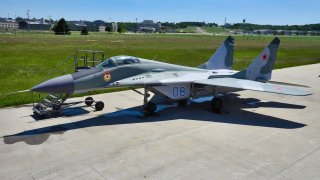America Secretly Bought 21 Russian-Built MiG-29 Fighters
At the end of the Cold War, the United States covertly purchased 21 Russian-built MiG-29 warplanes from Moldova to prevent their potential sale to Iran
Summary: At the end of the Cold War, the United States covertly purchased 21 Russian-built MiG-29 warplanes from Moldova to prevent their potential sale to Iran, which was feared to be seeking nuclear weapon capabilities.
-These aircraft were secretly transported to the U.S. and provided American pilots and military experts with invaluable insights into Soviet aviation technology. This acquisition allowed the U.S. -Air Force to study the MiG-29's advanced systems, notably its superior helmet-mounted cueing system, which offered better targeting than U.S. equivalents at the time.
The knowledge gained from these aircraft not only informed U.S. tactical training but also likely influenced advancements in American aerial combat technologies.
The Soviet-made MiG-29 warplane was equal to and, in some cases, surpassed the capabilities of the American F-15 and F-16 fighters. That was the conclusion of one of the American test pilots who flew the MiG-29 at the end of the Cold War. That pilot was one of many Americans.
No, that test pilot was not brought over to consult with the post-Soviet Russian government like so many Westerners were back in the 1990s. That test pilot flew the MiG-29 at an American military base. Because, unbeknownst to the public, the US military had purchased 21 MiG-29 warplanes at the end of the Cold War.
Moldova is a tiny country that sits dangerously near to Russia.
After the fall of the USSR, the tiny country found itself in possession of a fleet of 34 MiG-29s and eight Mi-8 Hip Soviet helicopters. Moldova could not afford to maintain this arsenal. Washington feared that the Moldovan government, desperate for funds, and with little else of value to sell, would sell these planes to Iran.
Moldova, Iran, and the MiG-29
Specifically, America’s leaders were concerned that Moldova would sell the MiG-29C variant to the Iranians. This is the MiG-29 that is equipped to carry nuclear weapons. Since Iran has been dedicated to acquiring nuclear weapons since the 1980s - at least, according to many experts - and the Americans believe such a move would be highly destabilizing for the Middle East region, Washington has striven to prevent such developments.
So, America bought a large tranche of these warplanes and shipped them covertly back to the United States aboard C-17 transports. They arrived in Dayton, Ohio, in 1997.
At that point, these birds became a favorite new, exotic toy for the US Air Force to play with (in secret, of course).
More than that, though, the Americans were able to glean significant intelligence on a warplane that it had otherwise had only limited working knowledge of. What was learned was helpful, especially now that, unfortunately, Russo-American relations are at their lowest point since the Cuban Missile Crisis in 1962.
Russian warplanes are a continual threat to US and NATO forces operating in Europe.
For American pilots to have an understanding of what their possible rivals in the Russian Air Force are trained to do, it could help them understand how to survive—and win—against them in a dogfight.
It wasn’t only the Americans who gained access to MiG-29s. The Israelis did, too. Likely out of concern that the Iranians might someday gain access to the MiG-29, the Israelis wanted to know what they were possibly up against. So, they also trained on these birds. The Israelis fell in love with the warplane. Like the Americans, they determined that the MiG-29 is a very difficult plane to dogfight with—unless it is in the hands of an experienced pilot.

It Takes a Skilled Pilot to Fly the MiG-29
That’s because the thrust on those birds is phenomenal.
What’s more, it lacks many of the accoutrements that pilots in American warplanes rely on. Although, the MiG-29 is not entirely lacking in high-technology. In fact, many reports suggest that the MiG-29’s helmet-mounted cueing system was more advanced than anything in either the American or Israeli arsenals when the MiG-29s were first tested by the West. This system the MiG-29 pilots to have more accurate targeting at greater angles than their American rivals.
Ultimately, that advantage would go away by 2003. But for more than a decade, the Russian MiG-29 had a better targeting capability than any American warplane did. The American acquisition of the MiG-29 might have even helped enhance the American warplane targeting systems. After all, exploitation units for the Air Force were given the MiG-29 to experiment with. The entire purpose of those units is to identify foreign technologies that might be useful and reverse-engineer them.
The acquisition of MiG-29s at the end of the Cold War was a bold and brilliant bit of intelligence work. It likely had immeasurable assistance in getting the Air Force to understand what they might be up against. Further, the Air Force probably perfected technologies that are now essential for US pilots in combat today.
About the Author
Brandon J. Weichert, a National Interest national security analyst, is a former Congressional staffer and geopolitical analyst who is a contributor at The Washington Times, the Asia Times, and The-Pipeline. He is the author of Winning Space: How America Remains a Superpower, Biohacked: China’s Race to Control Life, and The Shadow War: Iran’s Quest for Supremacy. His next book, A Disaster of Our Own Making: How the West Lost Ukraine, is due October 22 from Encounter Books. Weichert can be followed via Twitter @WeTheBrandon.


